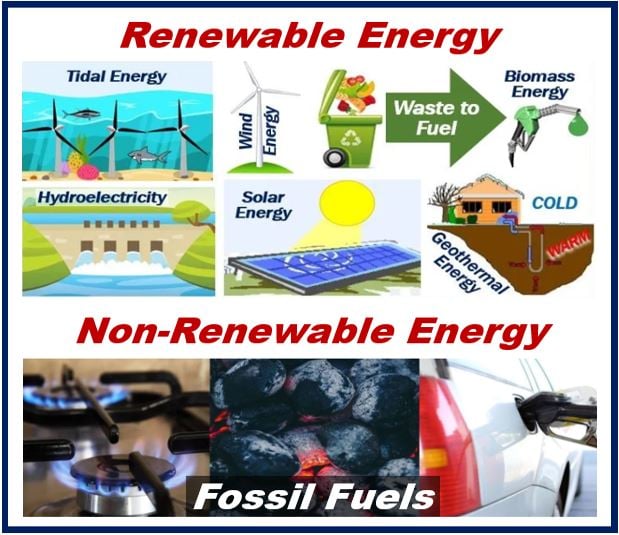What is sustainable energy? Definition and meaning
Sustainable Energy refers to energy produced from sources that can be used repeatedly and are not in danger of expiring or being depleted.
Two key components
There are two key components of sustainable energy; renewable energy and energy efficiency. They are considered to be the “twin pillars” of sustainable energy policy.

-
Renewable energy
Renewable energy refers to energy collected from renewable resources, such as sunlight, wind, rain, tides, waves, and geothermal heat. These sources of energy are naturally replenished and almost inexhaustible in duration.
-
Energy efficiency
Energy efficiency refers to reducing the amount of energy required to power products and services. This can be achieved by means of a more efficient technology or process. For example, modern energy efficient refrigerators use about 40 percent less energy than those of 2001.
The Cambridge Business English Dictionary defines sustainable energy as:
“Energy that is produced using the sun, wind, etc., or from crops, rather than using fuels such as oil or coal which cannot be replaced.”
Renewable energy vs. sustainable energy
Although renewable energy and sustainable energy appear in similar articles and conversations, their meanings are not the same.
Renewable energy goes on and on and on, it never runs out. However, it might not be sustainable if it damages the environment.
For example, we could focus on fast growing trees and replacing forests with new ones, thus, using wood to heat our homes. This would be a reliable type of renewable energy. However, the carbon emissions from burning wood would be high. Forests, therefore, are not a source of sustainable energy.
Solar energy, on the other hand, does not contribute to global warming. We could keep using it for hundreds of years without raising global temperatures or harming the environment. Solar energy is both renewable energy and sustainable energy.
It’s important to ensure that renewable energy sources are used in environmentally and economically sustainable ways to truly consider them as part of a sustainable energy strategy.
Put simply, sustainable energy is environmentally friendly and renewable.
Renewable energy technologies
The International Energy Agency states that there are three generations of renewable technologies, reaching back more than 100 years.
According to the IEA’s “Renewables in Global Energy Supply” fact sheet:
“First-generation technologies emerged from the industrial revolution at the end of the 19th century and include hydropower, biomass combustion, and geothermal power and heat – some of which are still in widespread use.
“Second-generation technologies include solar heating and cooling, wind power, modern forms of bioenergy, and solar photovoltaics.”
“Third-generation technologies are still under development and include concentrating solar power, ocean energy, enhanced geothermal systems, and integrated bioenergy systems.”
Green energy and green power
Green energy comes from sources that are naturally replenished. Natural sources that produce green energy include wind, rain, tides, sunlight, algae, and geothermal heat. These green energy sources are reducing our dependence on fossil fuels (coal, oil, and natural gas).
Demand for green energy depends a lot on its cost. As the cost of green energy drops, demand for it will rise.
According to a 2018 Forbes article citing a report from the International Renewable Energy Agency (IRENA), “the cost of renewable energy is dropping so fast that it should be a consistently cheaper source of electricity generation than traditional fossil fuels within just a few years.”
As technology progresses, the increased affordability of green energy solutions is expected to further accelerate the transition from traditional energy sources.
According to Mother Nature Network: “Advances in renewable energy technologies have lowered the cost of solar panels, wind turbines and other sources of green energy, placing the ability to produce electricity in the hands of the people rather than those of oil, gas, coal and utility companies.
“Green energy can replace fossil fuels in all major areas of use including electricity, water and space heating and fuel for motor vehicles.”
Compound phrases with “sustainable energy”
There are many compound phrases in the English language that contain the term “sustainable energy.” Let’s have a look at some of them, what they mean, and how they can be used in a sentence:
-
Sustainable Energy Solutions
Environmentally friendly and renewable energy options.
Example: “The conference on climate change focused on sustainable energy solutions for the future.”
-
Sustainable Energy Resources
Natural sources of energy that are renewable and have minimal impact on the environment.
Example: “Wind and solar are prime examples of sustainable energy resources.”
-
Sustainable Energy Policy
A plan or course of action by a government or organization to promote the use of sustainable energy.
Example: “The new government’s sustainable energy policy includes subsidies for solar panel installations.”
- Sustainable Energy Systems
Integrated methods and technologies for producing energy in sustainable ways.
Example: “The engineers designed a sustainable energy system that combined solar, wind, and geothermal power.”
- Sustainable Energy Practices
Methods of using or conserving energy that ensure long-term sustainability.
Example: “Households adopting sustainable energy practices are contributing to a cleaner environment.”
Two Videos
These educational videos, available on our affiliated YouTube channel Marketing Business Network, provide clear and easy-to-understand explanations of the terms ‘Sustainable Energy’ and ‘Renewable Energy.’
-
What is Sustainable Energy?
-
What is Renewable Energy?

